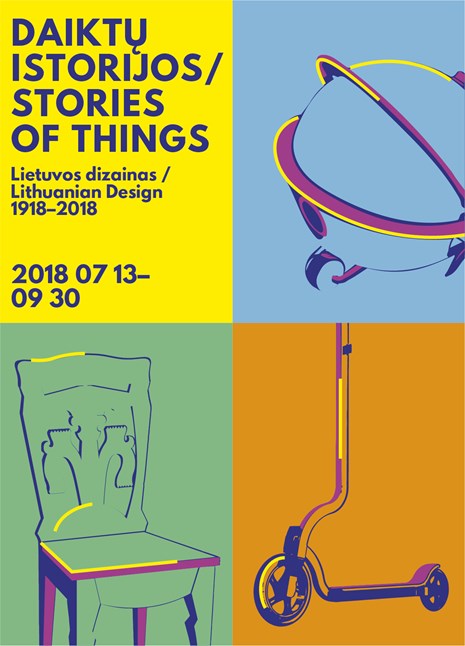Stories of Things

Stories of Things
Lithuanian Design 1918 - 2018
Man-made objects are the best illustrations of a country's
history. However, things often do not survive a country's crises.
While the state disappears, the nation holds on, and continues its
story, through literature, music, images, letters, and ultimately
through legends and tales. War, occupations, emigration,
repressions, exile and deportations quickly destroy things, and the
void is then filled with foreign artefacts.
It is easy to trace the beginning of the modern story of
Lithuanian design. In 1919, Professor Jonas Šimkus, the minister
for commerce and industry in the second government of Lithuania, in
his report 'Forthcoming Challenges to Lithuanian Industry', stated
the need to develop and produce various objects: textiles,
footwear, homes, office and trading equipment, crockery, scientific
instruments, toys, agricultural machinery, and wagons. Over the 20
years of independence, Lithuanian consumers not only became more
sophisticated, but were offered a generous selection of locally
designed objects, which were recognised by awards at many
international exhibitions. Who knows what the emerging Lithuanian
school of design would have gone on to look like: during the years
1940 to 1944, the story was interrupted by two occupations and one
reoccupation.
The postponed creative potential began to grow again when the
state, an alien state, needed objects again. The new story of
things also has a fixed beginning. In 1961, the Department of
Industrial Design was founded at the Lithuanian State Institute of
Art, in an almost empty space, where only the remnants of the
former abundance of things and the newcomers of the Stalinist
empire stood out. New graduate designers inevitably fell into the
trap of Soviet production and consumption. The Soviet Union was not
just an evil empire; it was also a poorly functioning empire. The
ideologised economy conflicted with the principles of good design,
and every eye-catching object made in Lithuania before 1990 is a
paradox worthy of a separate story.
After the restoration of independence, the metaphor of an empty
space threatened to become a reality for a third time. State-owned
design institutions, with their large commissions, disappeared, and
designers were not prepared for working and surviving in the global
capitalist market. But in practice, things went differently. The
emerging business world, both young and energetic, adapted quickly
to the new conditions, and by 1991 had already begun to export
Lithuanian-designed goods. The story of things changed its tune
again, turning obscure historical reflections and Soviet anecdotes
into success stories, adding an intriguing new twist to the story
of Lithuanian design.
The exhibition 'Stories of Things. Lithuanian Design 1918-2018',
held to mark 100 years of the restored Lithuanian state, tells us
how the design of objects and the designers themselves started in
Lithuania, revealing unexpected connections between history,
personalities and their projects.
Here you
can find the texts accompanying the exhibition "Stories of Things.
Lithuanian Design 1918-2018"
Curators: Karolina Jakaitė, Giedrė
Jankevičiūtė, Lijana Natalevičienė, Gintautė Žemaitytė, Ernestas
Parulskis
Authors of the texts: Karolina Jakaitė, Giedrė
Jankevičiūtė, Rasa Janulevičiūtė, Žilvinas Lidžius, Jurgita
Ludavičienė, Lijana Natalevičienė, Ernestas Parulskis, Auksė
Petrulienė, Vytis Ramanauskas, Adomas Rutkauskas, Gintautė
Žemaitytė
Exhibition lenders: Amber gallery, Energy and Technology Museum, Estonian Academy of Arts, Fondazione La Triennale di Milano, Kretinga Museum, Kupiškis Etnography Museum, Lithuanian Central State Archive, Lithuanian National Museum, Martynas Mažvydas National Library of Lithuania, M. K. Čiurlionis National Museum of Art, Money Museum, Šiauliai Aušros Museum, Museum of Vilnius Art Academy, Vytautas The Great War Museum, The Tamošaitis gallery "Židinys", Teresė Adomaitienė, Brigita Adomonienė, Diana Armonienė, Juozas Brundza, Stasys Brundza, Sigutė Chlebinskaitė, Jurgis Garmus, Vytautas Gečas, Jonas Gerulaitis, Rapolas Gražys, Karolina Jakaitė, Giedrė Jankevičiūtė, Kazimieras Januta, Nauris Kalinauskas, Jūratė Kavaliauskienė, Vytautas Kibildis, Audrius Klimas, Živilė Lukšytė, Ivanas Makmakas, Audronė Miliauskaitė, Gabrielė Naprušienė, Ina Novikova, Neringa Orlenok, Liudas Parulskis, Justa Petronienė, Auksė Petrulienė, Saulius Pilinkus, Marija Puipaitė, Kristina Pumputytė, Albinas Purys, Vytis Ramanauskas, Kęstutis Ramonas, Dalius Razauskas, Irena Rudzinskienė, Adomas Rutkauskas, Lygija Marija Stapulionienė, Benas Staškauskas, Birutė Stulgaitė, Ignas Survila, Algimantas Šarauskas, Aleksandras Šepkus, Simonas Tarvydas, Albinas Vaičiūnas, Sigitas Virpilaitis, Gintara Viskantė, Mindaugas Žilionis, Antanas Žilius, UAB "Acme group", design group "Akis", UAB "Deeper", VšĮ "Dizaino fondas", UAB "Elseta", UAB EMKO, Foreign Ministery of Lithuanian Republic, UAB "Gluk Media", design studio "Jot.Jot", UAB "Lauksva", Lithuanian Composers' Union, UAB "March design studio", UAB "Pixelmator Team", UAB "TeleSoftas".
Exhibition designers: Rokas Kilčiauskas, Adelė
Dovydavičiūtė
Organizer Lithuanian Art Museum / National
Gallery of Art, Vilnius
This project was partly financed by the Ministry of Culture of the Republic of Lithuania and the Lithuanian Council for Culture
Project partner: JCDecaux
Media sponsors: lrytas.lt, magazine Centras/Interjeras.lt, magazine Created in Lithuania, Lithuanian Design Forum


